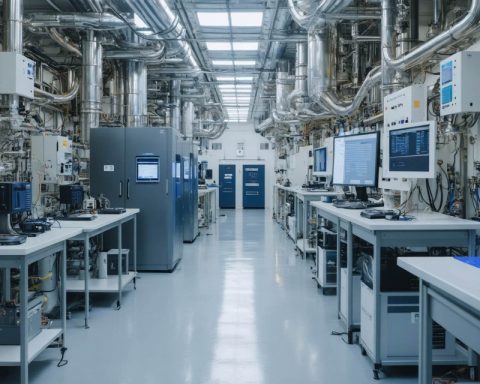- Lansing, Michigan is at the forefront of a transformative industrial shift with the Ultium battery manufacturing facility.
- LG Energy Solution (LGES) has taken full ownership of the facility, boosting Michigan’s role in green technology and sustainable energy solutions.
- Over $2 billion has been invested, securing Michigan’s position as a hub of automotive innovation and economic rejuvenation.
- The project promises 1,360 quality jobs, supporting Lansing’s skilled workforce and community prosperity.
- Lansing aims to be a key player in sustainable energy, impacting electric vehicles, energy storage, and advanced mobility sectors.
- This initiative supports onshoring essential technologies, enhancing Michigan’s status as an innovation center.
- The facility exemplifies Michigan’s enduring industrial legacy, attracting global talent and investment.
- Michigan emerges as a pivotal region in the shift towards a greener, self-reliant America.
Amidst the heartland of America’s automotive industry, a transformative shift is resonating through the streets of Lansing, Michigan. The bustling city is poised to secure its place in the annals of industrial innovation, as the Ultium battery manufacturing facility morphs into a beacon of technological progress and economic promise. With the recent strategic decisions related to the Lansing plant, LG Energy Solution (LGES) is taking the helm, fully owning the state-of-the-art facility and stirring expectations of a green-powered tomorrow.
The canvas of this industrial saga is painted with a swirl of determination and foresight. As LGES assumes full ownership, buoyed by the Michigan Strategic Fund Board’s support through the reallocation of incentives, the road to Lansing’s economic rejuvenation sweeps clearer. Imagine a facility, nearly complete at 98%, standing proud not just as any construction project but as a testament to a thriving eco-centric vision. Over $2 billion has been infused into this monumental endeavor, galvanizing the local economy and reinforcing Michigan’s reputation as a cradle of automobile innovation.
Anchored in this bustling milieu is a pledge—a promise of 1,360 quality jobs that serve as both the backbone and catalyst of the region’s renewed spirit. This isn’t merely a commitment on paper; it materializes in the livelihoods of Lansing’s skilled workforce, a community benefitting from a renewed sense of hope and opportunity. In the echoes of hammers and the whir of machinery, there is a rhythm of progress—a symphony of future-framed prosperity.
The implications extend far beyond job creation. With LGES’s strategic investment, Lansing strengthens its claim as a pivotal hub in the international push for sustainable energy solutions. It’s a dramatic dance of economy and ecology, set against the backdrop of America’s shifting industrial narrative. Electric vehicles, energy storage systems, and advanced mobility applications are not just technical aspirations; they are tangible goals being realized in Michigan’s soil.
Strategically, this shift also signifies a broader transition toward onshoring essential technologies—vital cogs in the machinery of sustainable energy independence. By corralling expertise within its borders, Michigan fortifies its status as a fortress of innovation, drawing talent and investment from across the globe.
For Lansing, the significance of this facility cannot be overstated. As Bob Lee of LGES remarked, Michigan’s strategic location and its vibrant workforce forge a potent combination for continued investment. It’s a clarion call to other enterprises, heralding a future where Michigan’s rich industrial legacy is not only preserved but reimagined.
In the narrative of modern industry, the Lansing battery plant stands as a lighthouse, guiding the path to a sustainable future. The message is clear: Michigan is not just a place on the map; it’s a pillar of progress, anchoring the ambitions of a greener, more self-reliant America.
Revving Toward a Green Future: Lansing’s Battery Plant Paves the Way
As the Ultium battery manufacturing facility in Lansing, Michigan, rises to prominence under the full ownership of LG Energy Solution (LGES), the transformation presents opportunities and challenges that reach beyond local borders. With this development, Lansing casts itself as a beacon of innovation and sustainable growth amid America’s evolving automotive industry landscape. Here, we dive deeper into aspects not fully explored in the source material, offering insights into how this shift could reshape economies and societies.
The Mechanics of Lansing’s Industrial Renaissance
1. Technological Impact and Skilled Job Creation
Lansing’s battery facility promises 1,360 jobs, indicative of a broader trend: the rise of skilled manufacturing positions in the green energy sector. As demand for electric vehicles (EVs) burgeons, manufacturers require a workforce adept in advanced battery technologies. According to a report by McKinsey, the EV sector could create over 10 million jobs globally by 2030, positioning regions like Lansing at the forefront of this employment wave.
2. Advanced Research and Development
The facility’s emphasis extends beyond production; it encompasses R&D for next-generation batteries, such as solid-state technologies. These advancements could revolutionize EVs by enhancing range, charging speed, and safety. BloombergNEF predicts solid-state batteries might dominate the market by 2030, stressing the importance of innovation hubs like Lansing.
Sustainable and Economic Implications
1. Environmental Footprint Reduction
By producing batteries domestically, Lansing cuts down the carbon footprint associated with importing components. According to the International Energy Agency, manufacturing locally can reduce transport-related emissions by up to 30%. This strategic onshoring aligns with global efforts to curb climate change and attain carbon neutrality.
2. Regional Economic Revitalization
The facility’s development is a boon not only for Lansing but also for Michigan’s economy. It is expected to inject over $2 billion into the local economy, potentially boosting ancillary industries such as logistics, construction, and services. Deloitte research highlights that investments in the EV supply chain can have a multiplier effect, revitalizing post-industrial regions.
Global Trends and Pressure Points
1. Competitive Edge in the Automotive Industry
Michigan’s strategic positioning as a hub for battery and EV production sharpens its competitive edge on a global scale. With the U.S. government incentivizing green technologies, via tax credits or grants, demand for domestic manufacturing capabilities grows. The Inflation Reduction Act of 2022 is one such legislative measure fueling this trend.
2. Geopolitical Considerations and Market Dynamics
The push towards localized manufacturing also insulates against geopolitical uncertainties impacting supply chains. The recent global chip shortages underscore the fragility of over-reliant import models, reinforcing Lansing’s utility as a self-reliant manufacturing locale.
Actionable Recommendations and Quick Tips
– For Entrepreneurs: Leverage Lansing’s burgeoning innovation ecosystem by forming partnerships with local stakeholders to explore opportunities in EV and battery technology markets.
– For Job Seekers: Develop expertise in advanced manufacturing and green technologies. Courses on lithium-ion battery technology and EV design can boost your employability in this growing sector.
– For Policymakers: Foster collaboration between government, academic institutions, and businesses to build a skilled workforce tailored to Michigan’s evolving industrial landscape.
Conclusion
Lansing’s Ultium battery facility is more than an industrial project; it symbolizes a shift toward sustainable innovation and energy independence. As the world gravely faces climate challenges, operations like Lansing’s underscore a pivotal movement in modern manufacturing. For further exploration on this transformative journey, visit LG Energy Solution to navigate the future of energy solutions.
In a world increasingly defined by ecological imperatives, Lansing demonstrates how cities can harness innovation and strategic investments to reinvent their industrial base. Prepare for a greener, fortified future as Lansing stands at the intersection of progress and possibility.
















